Older Primary Children (younger below)
Draw these pictures on the chalkboard or whiteboard. (Hint: If you can’t get into the Primary room beforehand, just draw them on poster board and bring them in. The lines don’t have to be precise, but general in the direction of the ups and downs.)
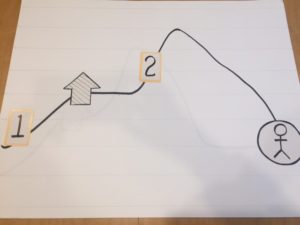
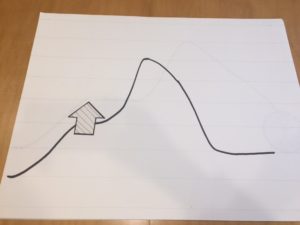

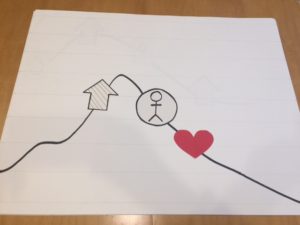
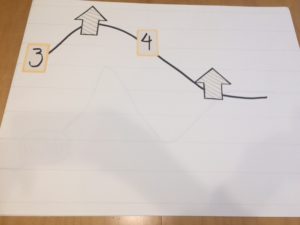
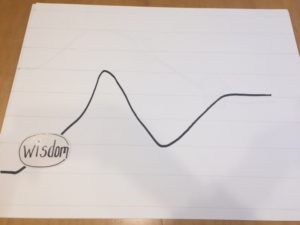
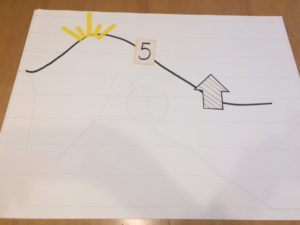
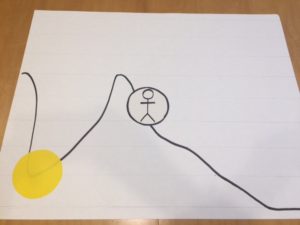
(For your information only, the stick figure circles stand for every time the song says you or your. The up arrows stand for every time the song says right. The numbers are for every time the song says choose or choice. The rays of yellow light stand for light. The round yellow dot stands for God. Don’t tell these to the children. Let them discover.)
Ask the children: What do you see? What do you notice? What do these pictures have to do with this song?
Sing the song for the children, then receive their answers. You may have to sing it again and again. You can run your finger along the black lines to give them some hints. You might ask “What do the numbers stand for?” then sing to help them figure out the answer. Continue with other questions, then sing to help them figure it out. “What do the arrows stand for?” “What does the yellow stand for?”
Once they have figured out what the symbols stand for, ask the children to sing only the words where there is a drawing and tell them you will sing the other words. Now switch and the children DO NOT sing any of the words with a symbol, but they DO sing all the rest of the words as you sing the words with a symbol.
This is an intriguing puzzle for the children. Running your finger along the black line as you sing helps them to recognize visually the ups and downs of the melody. Figuring out what the symbols mean help the children engage and invest in figuring out the song. Hearing the song over and over again while they are engaged in trying to figure out the song helps them map the song in their head and their memory. And it is fun!
Younger Primary Children
Show the children the map. Tell them that every time they see an arrow, you would like them to hit their fist pinky side down into the palm of the other hand.
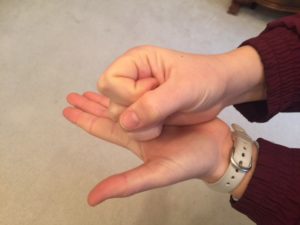
Ask a teacher to come up and be the leader of the fist to palm movements on the arrows.
Sing the song, running your finger along the line and pointing especially to the arrows where they are supposed to hit their fist to their palm. Ask the children what word was on each of the arrows. Receive their answers.
Now ask them to splay their fingers apart with both hands in front of them like the light of a flashlight each time the yellow light rays comes in the song AND hit their palm on the arrows.

Ask the teacher to again be the leader.
Sing the song, running your finger along the black line and pointing to the arrows and the rays of light. You may want to emphasize with your voice the words that come on each of those. The children and teacher leader are doing the movements on those symbols.
Ask the children if they noticed the little stick figure person in the circle. Ask, “What do you think that stands for?” Sing the first line, running your finger along the black line and emphasizing when you get to the word “you.” Receive their answers (You). Figure out a movement to do on the stick figure.
Ask the children if there are three or four of them that could be a leader with the teacher that has been helping you. Have them come up to the front. Remind them they are doing a movement on the arrows, the rays of light, and the stick figure.
Sing the song, running your finger along the black line and pointing especially to the arrows, the rays of light, and the stick figures. The children up front are leading the other children in the movements.
As the children “What word do we sing on the arrows? What word to we sing on the rays of light? What words do we sing on the stick figures?” Receive their answers.
Ask the children to do the actions and sing those words with you this time through the song.
The children will have engaged with the song, hearing it through at least 4 times while responding with movements. It helps them visualize the song, move to the song, and anticipate what words are coming next. And it is fun!

Kathy Visher
Great way to engage the kids, as always. Thank you for sharing your brilliant ideas!
nancy
Hi Sharla,
THANK YOU for sharing your ideas with us!!! I’m so grateful! I have question: I love this idea for introducing the song to the kids but I used your Melody Map lesson at the beginning of January to introduce As a Child of God and I wonder if it would be too soon to use this lesson since it’s so similar (I was thinking of starting to teach Choose the Right this Sunday). I hope that made sense. 🙂 If so, I will try a different activity instead. I would love to know your thoughts on this. Thank you.
Sharla Dance
Dear Nancy, The key is variety. If you use other activities in addition to the melody maps, the songs (through the activities) stay new to the children. Yes, use it, but the next Sunday or so also plan on either a crack the code, envelope game, or eraser pass for the older children to focus on words and an action word actions for the younger. Plan on a rhythmic movement to go with it for the Sunday after that like Paper Plates, Body Rhythms, rhythm sticks, or rhythm band. There are a few suggestions on my blog for the song, but there is a whole range of possibilities! Thanks for asking.
nancy
Thank you!!! I truly appreciate you taking the time to share your knowledge, experience and talents. 🙂
Suzanne
I love all your ideas for this song!!! It gets me really excited to teach it :). Thank you so much for posting several ideas here, I am already planning when to use each activity.
Jocelyn Meacham
so with the younger children, do you not worry about adding actions for the 1,2,3,4 (choose) symbols or the yellow (God) symbol? Is it too much to do and remember? Oh there is the heart symbol too.
Jocelyn Meacham
Oh I wish I could edit the above and start it with….THANK YOU first!!! I love your ideas, they are such a great source for all of us!!!
Sharla Dance
It depends on how young your children are. If you have 20 Sunbeams and CTR 4’s, don’t worry about the other symbols. If you have a big class of 7 year olds, you can challenge them because they’re the oldest to figure out what the numbers mean, etc. Thanks for asking!
Jocelyn Meacham
GOTCHA!! Makes sense! Thanks!
Megan
This worked really great for me today. I’ve been daunted by the other melody maps and so I haven’t tried them yet. This one was simple enough to try for my first time. I loved that there were also simple actions to make it better for junior primary. I actually used a roll of Ikea butcher paper to make mine and did the verse all on one piece and the chorus on another piece. It looked more like music that way and was much cheaper than poster board. Just in case anyone else has a smaller ward and budget like I do.
Sharla Dance
Butcher paper is a great idea, Megan! Thank you for giving the children variety in the way they learn and being willing to go for it!
Carolyn
Sharla ~ did anyone record your Payson workshop? I soooo wanted to attend, but we had a stake event I needed to be part of. If not, where else are you going to be “live and in person?”!! 🙂
Sharla Dance
Dear Carolyn, That was the only one in Utah for right now. My tech son has the recording and is going to do a “live” session, then edit it and put it up to buy (to pay the cost of editing) on the website. I’ll put out something so you will know. Thanks for asking!
P.S. I will be in Washington state in 2 weeks, then Portland Oregon in 4 weeks.
Melinda Harr
Thank you so much for teaching me about the melody map!! I watched your recording of you teaching a group of adults “As a Child of God” and that’s how I introduced the song to them. They picked up on the words quickly because they knew the melody. I will use the melody map, again, with Choose the Right for my younger children and one of your other activities for the older kids. Thank you!!! (Any chance you’re coming to Alaska to teach a class anytime soon 😉
Peggy Orr
I have a really dumb question. When is the Leader singing and when are the kids singing? When are both singing? In other words, I think the Leader 1st sings the song alone, but I’m not sure when the kids start to sing!! Sorry, I just need to get it right. I’m on a mission to integrate music into our Nursery in a more meaningful way and I’m so impressed with how you get results. I’m reading your book; music is not my gift except that I enjoy and feel the Spirit so I’d like to share this better with the Primary kids. I’m not a chorister, just a PC.
I noticed recently while observing Singing Time in the Nursery one of our little boys start to cry during a song. I know it was because he felt the Spirit! He couldn’t tell us, but I just know that was the case. I also have Grand children in Primary and would like to experiment with them. Planning to buy/make some musical things. Do you recommend a particular brand of hand bells?
Sharla Dance
Dear Peggy,
Question #1 – a young child needs to hear a song over and over again while they are participating (not necessarily singing) in order for it to lodge deeply into the brain. I often am singing alone, but I will ask the children to sing only the word that…. or sing only when I show the signal (flag goes up, bell rings, etc.). I let them sing only select portions, but the words and melody of the song are going through their heads so that they can sing at the right time… a very powerful way to learn.
Nursery –
You are so right that the little ones in Nursery need manipulatives to hold! We use scarves, shakers, popsicle stick puppets, etc., one for every song. I am doing a workshop in Washington next week for Nursery music. I will try and post some of the things!
I use Kid’s Play handbells because of their true pitch. Thanks for asking.
Jessica
Thank you for these ideas! I have just started scowering your site this week and I am finding it so helpful. When you introduce songs, do you have the pianist accompany you or do you prefer to sing acapella? Have you noticed which is better for the children in the early stages of learning?
Sharla Dance
Jessica, If you can sing without the piano at first, it is helpful for the children because the sound waves of the human voice are easier to match pitch with than the piano as they are learning. The piano is the frosting on the cake and provides so many harmonies that the children also need to hear, but it should come second if possible. If you’re worried about staying on pitch, though, don’t hesitate to use the piano. Also, thank you for your kind words. Thanks for asking!
Kaylee
Hi, how would you recommend teaching the second and third verses of this song? Are there melody maps for those verses as well?
Thank you so much for all you do!!
Sharla Dance
I know that some people on the LDS Primary Choristers Facebook page have made some melody maps for those verses. Thanks for asking!
Lynn
I’m making this simple melody map for I’m trying to be like Jesus. But, I have a general question for making any melody map…. If I do this on one long butcher paper sheet, do I need to break up the phrases or can I just keep them all connected?
Sharla Dance
I find them easier to put up if they are in 4 or 8 sections. Sometimes with the older children, I ask if these are in the right order as I sing, and they have to figure out which comes first! Thanks for asking.
Lynn
Hi Sharla, I loved your 2017 workshop video. I love the Melody Map for so many reasons. You just made it so much fun to watch. I noticed in the video on the younger version you did not have them sing the words with actions but you had them make a sound effect to go with the action. I loved that. Here on your site you have them sing the word with the action. I love both ideas and not sure if you would want to somehow fit both in. I did notice that you sometimes actually sang the word as they did the action with the sound effect in the video.
Sharla Dance
Both ways work, but it seems with the vigor of this particular song to work really well doing the sound effect with the action and I would occasionally sing the word while they were doing the action. The children are learning where to place the particular words (represented by the action and sound effect) into the whole picture of the song… where is it rhythmically, where is it in the melody, when does it come in the song. We all learn those things when we learn a song. It’s just more fun this way!